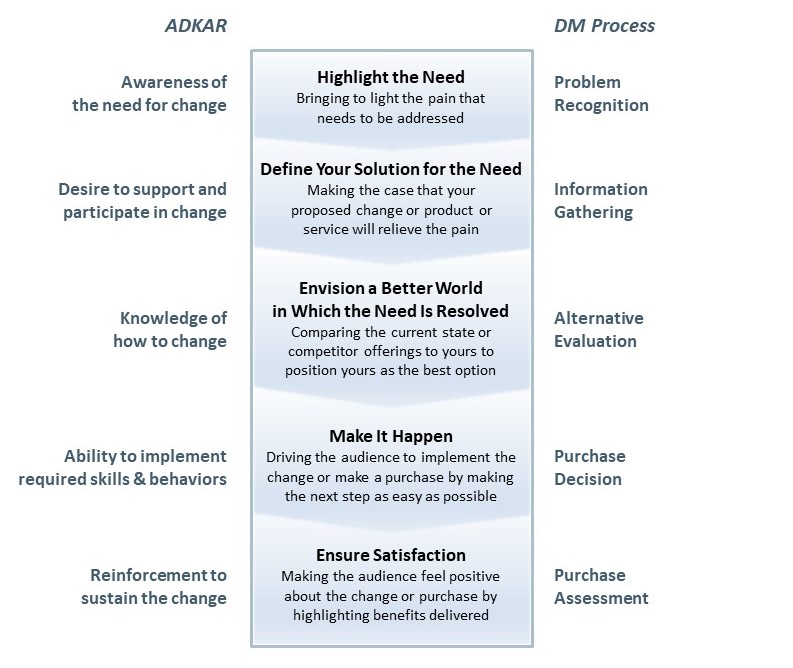In previous blogs, we highlighted six questions common to successful marketing and change management initiatives and common communication requirements across the five stages of audience journeys in adopting change. Now we want to go into the tactical implications of those communication requirements for change management.
There is a trope in love stories and RomComs of one character professing love for another through the words “you complete me.” Like many clichés, it has currency because it’s grounded in an experienced truth: In successful relationships, each partner possesses attributes that shore up weaknesses in the other so that together they are both stronger. That’s how it is with marketing and change management.
As we discussed previously, the similarity of the audience journey in the ADKAR framework to the customer decision-making journey is in the key communication considerations within each framework. Based on this foundation, marketing can help “complete” change management by offering communication best practices and ideas for each stage.
AWARENESS. Communications must highlight the need, bringing to light the pain that needs to be addressed. To be compelling, communication of that pain must be both credible and empathetic.
Examples of marketing communications at this stage:
- Emails and presentations that explain the change in terms of its impact on all team members, coming from executive leaders
- FAQs that capture and provide honest answers to real questions likely on the minds of team members
DESIRE. Communications must define the proposed change as the solution to the need, i.e., the best way to relieve the pain. To be successful, these communications must reach the “heart” and the “mind” of the audience by appealing to emotions and logic.
Examples of marketing communications at this stage:
- Case studies of early, quick “wins” that highlight the benefits realized through the change
- Infographics presenting the need for change and its potential benefits in simple, visual terms
KNOWLEDGE. Communications must create a solid understanding of the world after the change, in contrast with the current state. To be effective, these communications must make the case that the future state is close at hand and that the path to get there is very simple.
Example of marketing communications at this stage:
- How-to videos and one-page quick-reference guides that make the path to implementation seem easy; brevity and visuals take priority over words and detailed use cases
ABILITY. Communications must minimize the perceived effort involved in change and reduce friction to take the first step. Successful communications at this stage offer a helping hand—not condescending but by providing clear, simple guidelines that encourage the audience to move down the path.
Examples of marketing communications at this stage:
- Training materials and tools that provide comprehensive information about how to accomplish current tasks in the new state and instill confidence that change can be achieved
- Gamification that turns mundane change into activities that confer status or create excitement for team members
REINFORCEMENT. Last, but definitely not least, communications must continue to celebrate the benefits delivered. Many change initiatives fail because they are thought of as a “one and done” proposition in which a single, intense effort suffices. Instead, the initiatives need to be promoted over an extended time period to bring along laggards and solidify the changes already made by early adopters.
Examples of marketing communications at this stage:
- Success stories/testimonials highlighting the benefits achieved and improvements gained, not only in quantitative terms but in human, emotional terms
- Awards to bring attention to change-driven achievements and, in the process, elicit feelings of aspiration and potentially competitiveness
Here’s the bottom line: if you’re not thinking about change management like a marketer and marketing like a change management leader, you probably missing something that could elevate the impact of your efforts.

